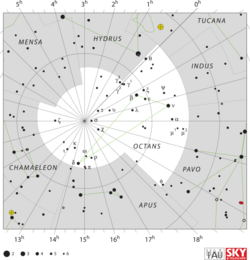Astronomy:Chi Octantis
| Observation data Epoch J2000.0 Equinox (celestial coordinates) | |
|---|---|
| Constellation | Octans |
| Right ascension | 18h 54m 47.14062s[1] |
| Declination | −87° 36′ 21.0359″[1] |
| Apparent magnitude (V) | 5.28±0.01[2] |
| Characteristics | |
| Spectral type | K3 III[3] |
| U−B color index | +1.60[4] |
| B−V color index | +1.28[4] |
| Astrometry | |
| Radial velocity (Rv) | 33.6±3.1[5] km/s |
| Proper motion (μ) | RA: −36.555[1] mas/yr Dec.: −135.715[1] mas/yr |
| Parallax (π) | 12.5114 ± 0.0730[1] mas |
| Distance | 261 ± 2 ly (79.9 ± 0.5 pc) |
| Absolute magnitude (MV) | +0.81[6] |
| Details | |
| Mass | 1.25±0.33[7] M☉ |
| Radius | 15.6±0.8[8] R☉ |
| Luminosity | 73.6±0.7[9] L☉ |
| Surface gravity (log g) | 2.19[10] cgs |
| Temperature | 4,266+99−97[7] K |
| Metallicity [Fe/H] | +0.10[10] dex |
| Rotational velocity (v sin i) | <1[11] km/s |
| Other designations | |
| Database references | |
| SIMBAD | data |
Chi Octantis, Latinized from χ Octantis, is a solitary star[13] located in the southern circumpolar constellation Octans. It is faintly visible to the naked eye as an orange-hued star with an apparent magnitude of 5.28.[2] The object is located relatively close at a distance of 261 light years based on Gaia EDR3 parallax measurements,[1] but it is receding with a heliocentric radial velocity 33.6 km/s.[5] At its current distance, Chi Octantis' brightness is diminished by 0.24 magnitudes due to interstellar dust.[14] It has an absolute magnitude of +0.81.[6]
Chi Octantis is an evolved red giant with a stellar classification of K3 III.[3] It has 125% the mass of the Sun and an enlarged radius of 14.45 R☉ due to its evolved state.[7] It radiates 73.6 times the luminosity of the Sun[9] from its photosphere at an effective temperature of 4,266 K.[7] Chi Octantis is metal enriched with an iron abundance 126% that of the Sun ([Fe/H] = +0.10)[10] and spins slowly with a projected rotational velocity less than 1 km/s−1.[11]
References
- ↑ 1.0 1.1 1.2 1.3 1.4 Brown, A. G. A. (2021). "Gaia Early Data Release 3: Summary of the contents and survey properties". Astronomy & Astrophysics 649: A1. doi:10.1051/0004-6361/202039657. Bibcode: 2021A&A...649A...1G. Gaia EDR3 record for this source at VizieR.
- ↑ 2.0 2.1 Høg, E.; Fabricius, C.; Makarov, V. V.; Urban, S.; Corbin, T.; Wycoff, G.; Bastian, U.; Schwekendiek, P. et al. (March 2000). "The Tycho-2 catalogue of the 2.5 million brightest stars". Astronomy and Astrophysics 355: L27–L30. ISSN 0004-6361. Bibcode: 2000A&A...355L..27H.
- ↑ 3.0 3.1 Keenan, Philip C.; McNeil, Raymond C. (October 1989). "The Perkins catalog of revised MK types for the cooler stars". The Astrophysical Journal Supplement Series 71: 245. doi:10.1086/191373. ISSN 0067-0049. Bibcode: 1989ApJS...71..245K.
- ↑ 4.0 4.1 Johnson, H. L.; Mitchell, R. I.; Iriarte, B.; Wisniewski, W. Z. (1966). "UBVRIJKL Photometry of the Bright Stars". Communications of the Lunar and Planetary Laboratory 4: 99–110. Bibcode: 1966CoLPL...4...99J.
- ↑ 5.0 5.1 Gontcharov, G. A. (November 2006). "Pulkovo Compilation of Radial Velocities for 35 495 Hipparcos stars in a common system". Astronomy Letters 32 (11): 759–771. doi:10.1134/S1063773706110065. ISSN 1063-7737. Bibcode: 2006AstL...32..759G.
- ↑ 6.0 6.1 Anderson, E.; Francis, Ch. (May 2012). "XHIP: An extended hipparcos compilation" (in en). Astronomy Letters 38 (5): 331–346. doi:10.1134/S1063773712050015. ISSN 1063-7737. Bibcode: 2012AstL...38..331A.
- ↑ 7.0 7.1 7.2 7.3 Allende Prieto, C.; Lambert, D. L. (December 1999). "Fundamental parameters of nearby stars from the comparison with evolutionary calculations: masses, radii and effective temperatures". Astronomy and Astrophysics 352: 555–562. ISSN 0004-6361. Bibcode: 1999A&A...352..555A.
- ↑ Kervella, P.; Thévenin, F.; Di Folco, E.; Ségransan, D. (October 2004). "The angular sizes of dwarf stars and subgiants". Astronomy & Astrophysics 426 (1): 297–307. doi:10.1051/0004-6361:20035930. ISSN 0004-6361. Bibcode: 2004A&A...426..297K.
- ↑ 9.0 9.1 Brown, A. G. A. (August 2018). "Gaia Data Release 2: Summary of the contents and survey properties". Astronomy & Astrophysics 616: A1. doi:10.1051/0004-6361/201833051. Bibcode: 2018A&A...616A...1G. Gaia DR2 record for this source at VizieR.
- ↑ 10.0 10.1 10.2 Anders, F.; Khalatyan, A.; Chiappini, C.; Queiroz, A. B.; Santiago, B. X.; Jordi, C.; Girardi, L.; Brown, A. G. A. et al. (August 2019). "Photo-astrometric distances, extinctions, and astrophysical parameters for Gaia DR2 stars brighter than G = 18". Astronomy & Astrophysics 628: A94. doi:10.1051/0004-6361/201935765. ISSN 0004-6361. Bibcode: 2019A&A...628A..94A.
- ↑ 11.0 11.1 De Medeiros, J. R.; Alves, S.; Udry, S.; Andersen, J.; Nordström, B.; Mayor, M. (January 2014). "A catalog of rotational and radial velocities for evolved stars: V. Southern stars⋆⋆⋆". Astronomy & Astrophysics 561: A126. doi:10.1051/0004-6361/201220762. ISSN 0004-6361. Bibcode: 2014A&A...561A.126D.
- ↑ "chi Octantis". SIMBAD. Centre de données astronomiques de Strasbourg. http://simbad.u-strasbg.fr/simbad/sim-basic?Ident=chi+Octantis.
- ↑ Eggleton, P. P.; Tokovinin, A. A. (11 September 2008). "A catalogue of multiplicity among bright stellar systems". Monthly Notices of the Royal Astronomical Society 389 (2): 869–879. doi:10.1111/j.1365-2966.2008.13596.x. ISSN 0035-8711. Bibcode: 2008MNRAS.389..869E.
- ↑ Gontcharov, George A.; Mosenkov, Aleksandr V. (28 September 2017). "Verifying reddening and extinction for Gaia DR1 TGAS main sequence stars". Monthly Notices of the Royal Astronomical Society 472 (4): 3805–3820. doi:10.1093/mnras/stx2219. ISSN 0035-8711. Bibcode: 2017MNRAS.472.3805G.
<ref> tag with name "Gould1879" defined in <references> is not used in prior text.
 |


